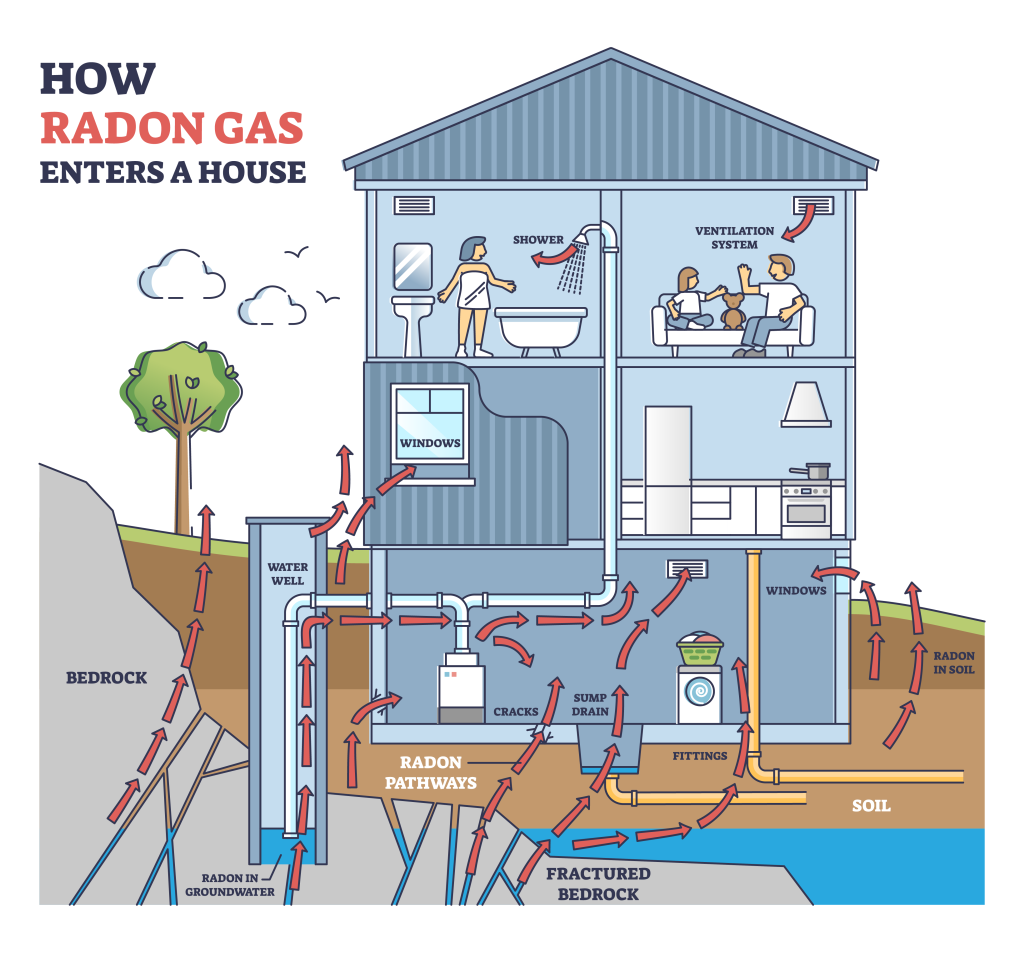What Is Radon?
How can it affect your Health?
January is National Radon Action Month, a time to shine a light on this invisible yet deadly gas. Radon is a silent threat lurking in homes, schools, and workplaces, and understanding it could save lives.
What Is Radon?
Radon is a naturally occurring radioactive gas that forms when uranium in the soil, rocks, or water breaks down. Because radon is colorless, odorless, and tasteless, it’s undetectable without proper testing. 1, 2
Radon gas moves through the ground and enters buildings through:
• Cracks in walls, floors, and foundations.
• Construction joints and gaps around pipes.
• Cavities inside walls.
• Even well-sealed and newer homes can have radon issues.3
How does Radon affect your health?
Radon is the second leading cause of lung cancer in the U.S., contributing to over 20,000 deaths annually.1, 4 Smokers exposed to radon have an even higher risk of developing lung cancer.4
When radon gas is inhaled, its radioactive particles can lodge in the lining of the lungs. Over time, these particles emit radiation, damaging lung tissue and increasing the risk of cancer. This process can take years, making radon exposure a silent and long-term health hazard.⁵
While radon exposure doesn’t cause immediate symptoms like coughing or shortness of breath, the danger lies in its cumulative effect over time. This is why detection and prevention are critical.
How do you detect Radon?
Since radon is invisible and odorless, testing is the only way to determine its presence in your home or workplace. Here’s how:
DIY Radon Test Kits and Monitors:
• Available online or at hardware stores, these kits and monitors are an affordable way to measure radon levels.
• Follow the instructions to place the kit in your home, typically in the basement or lowest level used regularly.
• Send the kit to a lab for analysis, and you’ll receive results within a few weeks.6
• Place monitors based on manufacturer’s instructions and receive results through mobile app or device display.
Professional Radon Testing:
• Certified radon inspectors use advanced equipment for accurate, real-time measurements.
• They can also identify specific entry points and recommend solutions.1
The Environmental Protection Agency (EPA) suggests taking action if radon levels are at or above 4 pCi/L (picocuries per liter). However, even lower levels can pose risks over time.2

How to reduce Radon levels in your home?
If your home tests positive for high radon levels, there are several ways to mitigate the risk:
Install a Radon Mitigation System:
• A common solution is a vent pipe system and fan that draws radon from beneath the house and releases it safely outdoors.
• This is known as sub-slab depressurization and is effective in reducing radon levels.3
Seal Entry Points:
• Seal cracks in floors, walls, and foundations to minimize radon infiltration. While not a standalone solution, this can reduce radon levels.⁷
Increase Ventilation:
• Improve air circulation by installing vents or opening windows when possible.⁷
Regular Maintenance:
• Test radon levels every 2-5 years or after major renovations, as these can alter how radon enters your home.2
Who should test for Radon?
Everyone should test their home for radon, regardless of the home’s age or location. However, certain factors make testing especially important:
• Geographic Location: Areas with high uranium content in the soil are more prone to radon issues. Check the EPA’s Radon Zone Map for guidance.2
• Homeowners with Basements: Radon tends to accumulate in lower levels of a building.6
• After Major Renovations: Changes to your home’s structure can impact radon levels.6
Why Is January the right time to test?
Winter is ideal for radon testing because:
• Homes are sealed to keep out cold air, making radon levels more concentrated.
• Testing during this time provides an accurate picture of worst-case radon exposure.7
Take Action Today!
National Radon Action Month is the perfect time to ensure your home is safe from this invisible threat.
• Step 1: Get a test kit or hire a professional.
• Step 2: Address any radon issues promptly.
• Step 3: Share what you’ve learned with friends and family to spread awareness.
©2025ProgressiveHealth References:
1. EPA Radon Facts: https://www.epa.gov/radon
2. World Health Organization Radon Report
3. American Lung Association: Radon and Your Health
4. National Cancer Institute: Radon and Cancer Risk
5. Centers for Disease Control and Prevention: Radon Information
6. Radon Mitigation Standards for Schools and Large Buildings, ANSI/AARST
7. Radon Testing and Reduction, National Radon Safety Board

